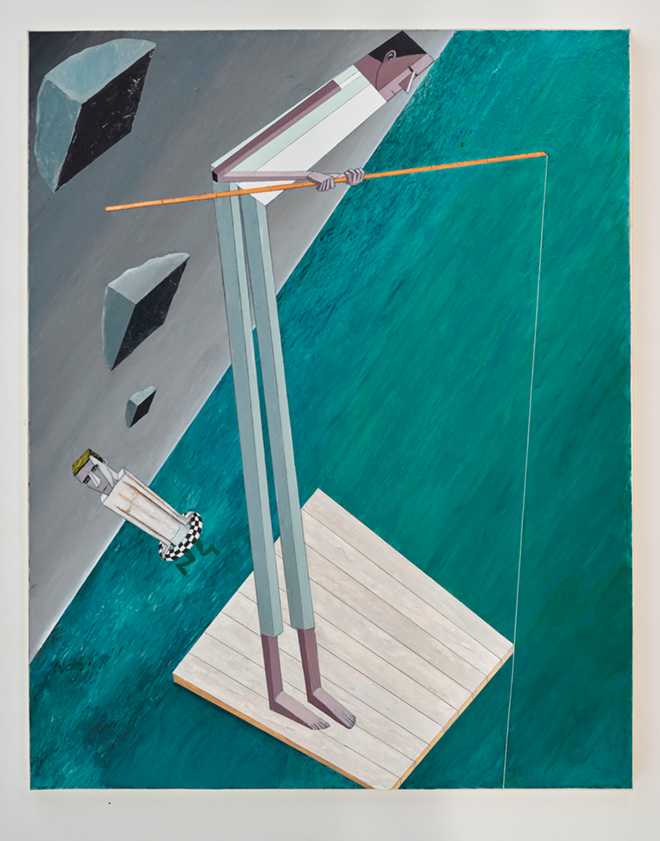During this time of the year, you’re not likely to want to be around any units of measurement (especially after holiday feasts), but you’ll want to head over to the Tampa Museum of art to check out Getting Measured, a retrospective of works by Mernet Larsen that is this year’s don’t-wait-just-go exhibition.
Larsen has been a huge part of the Tampa art community, having taught at USF from 1967-2003 (she still lives and works here as well as NY). This survey of works from 1957 to freshly painted pieces from this year gives viewers the whole picture of Larsen’s natural talents.
Starting from the early works, one thing is clear: Larsen has an eye for detail and is an exquisite draftsman. The gridding seen in “Last Tango” (1975) or the precision in “Teapot with Reflection” (1968-69) show the breadth of ability that transfers to her later works. Larsen seems to have had her big breakthrough when she had the opportunity to travel to Japan on a six-week research trip through USF. Bunraku puppetry and 12th-century Japanese scrolls influenced Larsen’s painting, along with 15th-century Italian painting and the geometric works of El Lissitzky.
While the earlier works are wonderful in their own right, the calculated simplicity of Larsen’s geometric figuration is what stops me in my tracks. Compositions have been cut back over the years, allowing the interlocking forms of the figure and background to interact more, as in “Getting Measured,” a piece that will make you melt: It has the visual weight and textural heft of a marble sculpture, the careful draftsmanship of an architectural blueprint and the pure bliss and poetics of painting.
Even if you took the face away, some of the most expressionistic parts of the figures can be found in the carefully painted hands and feet. The combination of a well-modeled foot next to a flat-toned heel and leg add to the work’s complexity, and everything is always done with tenderness (and if you aren’t wooed by those perfectly pinched fingers, I’m pretty sure you aren’t human).
Most of her works focus on unexpected everyday activities — boring meetings, eating a salad, reading in bed — but in these quiet moments, touches of subtle humor or awkwardness make you want to figure them out. I hadn’t seen Larsen’s work in person before, so I’d assumed they were pretty flat, but I was rewarded with glorious surfaces: gritty layers are built up then unearthed in some sections. In other areas, the tracing paper attached to the canvas starts to fold or peel up from the surface, giving it a worn look. Larsen definitely knows the meaning of play when it comes to paint, and for that our eyes are forever grateful.
I feel like the museum must have been listening to my inner monologue when I wondered, “Why can’t we have more great paintings like this in Tampa?” Wish granted: Tampa Collects members have recently voted for the acquisition of “Raft” into TMA’s permanent collection. In this image, one of the freshest canvases to come from her studio, a fisher with a cane pole peers down into the water to see what’s biting his line, while the man behind him stiffly sits in a raft, his baby-like legs dangling in the water.
There’s something so-wrong-it’s-right about compositions like this one (and even like its neighbor “Misstep”) where the figures literally fill the canvas to its edges and seem even to be propping the stretcher bars up in place.
In “Raft,” the man’s head pivots on the top edge, mimicking the wooden raft that balances on knifepoint at the bottom. The geometries in this painting will have your eyes bouncing along these compositional trails like a ping-pong ball.
It’s clear how many people she has inspired as a professor, mentor, and painter over the years. She’s a true master of contradictions: soft and hard, humor and seriousness, additive and subtractive — somehow finding a totality of humanity within the edges of the canvas. I’m almost embarrassed to admit how much time I spent in this exhibit, especially knowing I wanted to come back a few more times before it ends, but Larsen’s work hits you right in that soft spot. Not that I have a say in the grand scheme of art history or anything, but in my humble opinion, she’s a master — period — and certainly deserves to be highlighted with this well thought-out retrospective.
Caitlin Albritton, CL Tampa's visual arts critic, spends her time tracking down art you might not see anywhere else. She's also an artist in her own right. Follow her on Instagram or read her blog.


